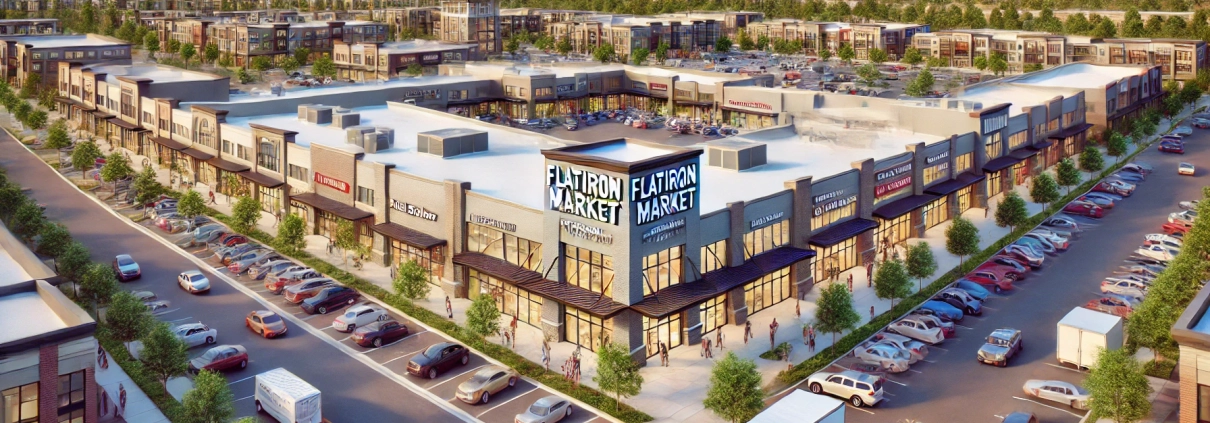Neighborhood Center
Neighborhood retail centers are also convenience-related and typically have just one anchor, usually grocery or drug stores. A neighborhood center is around 75,000 SF with a trade area of 3 miles.
Source: ICSC
Putting ‘Neighborhood Center’ in Context
Scenario Overview
Summit Retail Partners, a real estate private equity firm, is acquiring a neighborhood shopping center called Flatiron Market in Boulder, Colorado. The property, a 75,000 SF retail center, is anchored by a regional grocery chain and complemented by several smaller tenants, including a dry cleaner, a nail salon, a fitness studio, and a quick-service restaurant. Flatiron Market serves the surrounding neighborhoods within a three-mile trade area, which encompasses approximately 50,000 residents.
Property Details
Flatiron Market was built in 2005 and has been well-maintained. The property is currently 92% leased with a weighted average lease term (WALT) of 5.5 years. The grocery anchor occupies 40,000 SF and generates 35% of the property’s annual rental revenue. The in-line tenants average 1,500-2,000 SF per space. Annual net operating income (NOI) for the property is $1.8 million, with a going-in cap rate of 6.25%.
Investment Strategy
Summit Retail Partners classifies this investment as core-plus due to the high occupancy and stable anchor tenancy but sees potential for growth by filling the vacant spaces and increasing rents as leases roll over. They plan to implement modest improvements, such as enhancing the façade and upgrading parking lot lighting, to maintain the center’s competitive position in the market.
Neighborhood Center Context
Flatiron Market epitomizes a neighborhood retail center with its grocery-anchor and mix of convenience-based tenants designed to cater to local residents’ daily needs. The three-mile trade area reflects the natural draw of such centers, as customers are typically unwilling to travel long distances for essentials like groceries or quick errands. The property benefits from strong visibility on a major arterial road and ample parking, both critical for attracting and retaining tenants.
Example Calculation: Cap Rate and Trade Area Analysis
The acquisition price of Flatiron Market was $28.8 million, derived from the NOI and the going-in cap rate:
- Cap Rate = NOI ÷ Purchase Price
- Rearranged for Purchase Price: Purchase Price = NOI ÷ Cap Rate
Calculation:
$28,800,000 = $1,800,000 ÷ 0.0625
Additionally, a demographic analysis reveals that the three-mile trade area includes households with an average annual income of $110,000, reinforcing the viability of the neighborhood center’s tenant mix.
Conclusion
Flatiron Market demonstrates the characteristics of a well-located, convenience-oriented neighborhood shopping center. With steady income from the anchor tenant and room for growth through leasing and small capital improvements, the property is a strong fit for Summit Retail Partners’ core-plus strategy.
Frequently Asked Questions about Neighborhood Centers in Retail Real Estate
What is a Neighborhood Center?
A Neighborhood Center is a convenience-oriented retail center “typically with just one anchor, usually a grocery or drug store.” It averages 75,000 square feet and serves a three-mile trade area. (Source: ICSC)
What types of tenants are found in a Neighborhood Center?
Tenants often include a grocery or drug store anchor along with convenience-based retailers such as dry cleaners, nail salons, fitness studios, and quick-service restaurants.
How does Flatiron Market reflect the characteristics of a Neighborhood Center?
Flatiron Market is a 75,000 SF retail center anchored by a regional grocery chain, with a mix of in-line tenants and a defined three-mile trade area, serving around 50,000 residents.
What are the financial metrics of Flatiron Market?
• NOI: $1.8 million
• Cap Rate: 6.25%
• Purchase Price: $28.8 million
Derived from: $1,800,000 ÷ 0.0625 = $28,800,000
What is the investment strategy for Flatiron Market?
Summit Retail Partners classifies the property as core-plus, targeting growth by filling remaining vacancies, increasing rents on lease rollover, and making minor capital improvements.
Why is trade area analysis important for Neighborhood Centers?
Because these centers are convenience-focused, customers typically won’t travel far. The three-mile radius reflects expected consumer behavior for daily needs.
What demographics support the success of Flatiron Market?
The trade area includes households with an average income of $110,000, supporting the mix of tenants and pricing at Flatiron Market.
Click here to get this CRE Glossary in an eBook (PDF) format.

